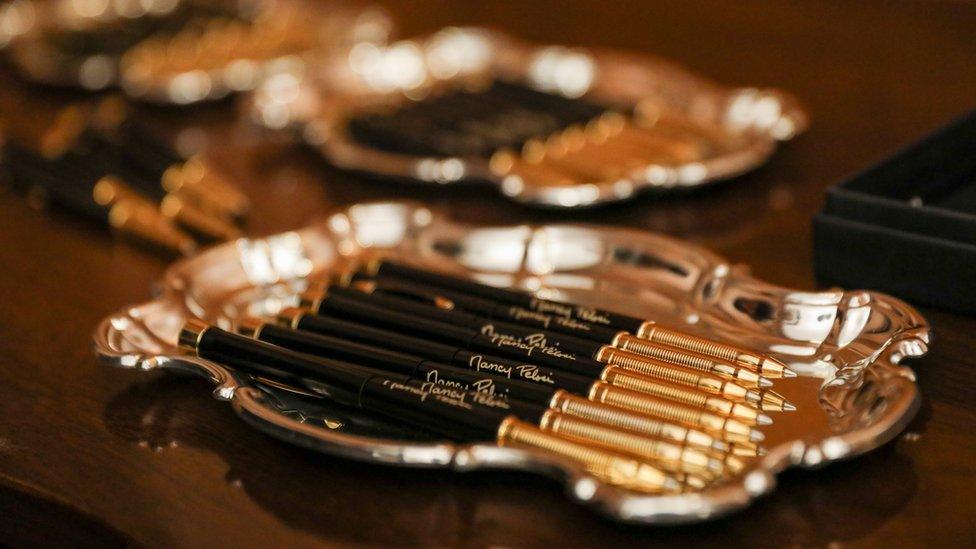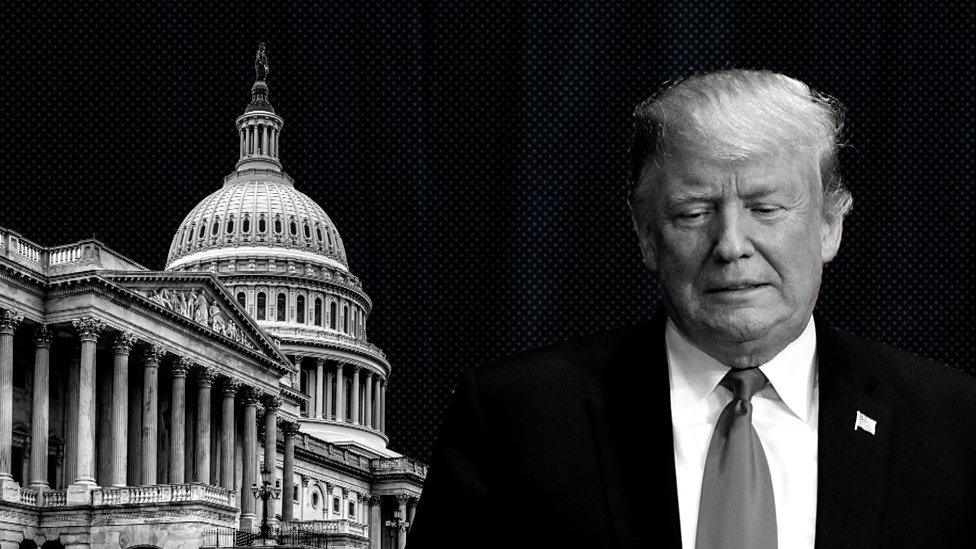Impeachment trial: Why did Pelosi use so many pens?
- Published

Nancy Pelosi used pens engraved with her name to sign the articles of impeachment
The US Senate formally received the articles on impeachment from the House on Thursday.
The whole process has been more colourful, and dramatic, than your standard Congress fare.
Speaker Nancy Pelosi used several pens to put her signature on the impeachment bill - annoying Republicans - before House Democrats and the House clerk formally marched over to the Senate Chamber to present the articles.
And the sergeant at arms kicked off proceedings on Thursday with a medieval-sounding threat: "Hear ye, hear ye, hear ye, all persons are commanded to keep silent, on pain of imprisonment."
It's rare to see so much pomp and circumstance in the US Congress, which typically has far fewer ceremonial traditions than the UK's Parliament.
Here's a breakdown of what happened, and what it means.
A 'funny signature' with many pens
Ms Pelosi and her team held an engrossment ceremony on Wednesday evening, where she signed the final articles of impeachment. This is the last, formal step the House takes before it hands over the impeachment proceedings to the Senate.
It took her some time - because she used a different pen for each stroke, joking: "It makes a funny signature."
Reporters snapped photos of four trays, each holding eight pens engraved with Ms Pelosi's name, before the signing ceremony.
Speaker Nancy Pelosi signed the articles of impeachment
This is actually a long-standing US tradition - since President Franklin Roosevelt, presidents have frequently used multiple pens to sign high-profile pieces of legislation, so they can be offered as souvenirs and historical keepsakes.
President Donald Trump joked that he was running out of pens as he signed legislation on his inauguration day - while President Barack Obama used 22 pens to sign the Affordable Care Act into law.
Ms Pelosi has faced criticism for using several pens to sign the impeachment articles - with Republican critics saying she appeared to be celebrating what was supposed to be a sombre moment.
Her office, however, argued that while impeachment is "tragic... it is indisputably historic when the Constitution and its balance of power reasserts itself."
Back in 1998, Republican senators also kept pens as souvenirs after signing oaths for the impeachment trial of President Bill Clinton - although those pens had typos on the text inscribed on them, and had to be reissued.
An impeachment walk - twice
Following Wednesday's signing, the House clerk walked across the Capitol, under the iconic Rotunda, to deliver the two articles of impeachment to the Senate.

House clerk Cheryl Johnson and Sergeant of Arms Paul Irving led Wednesday's procession
She was accompanied by the House Sergeant at Arms and the seven impeachment managers.
It was a rare moment when members of the House formally crossed over to the Senate - typically, the two chambers function separately.
The tradition of the procession is thought to go back to the impeachment of President Andrew Johnson in 1868. Lawmakers also made the same walk in 1998, when carrying articles impeaching President Bill Clinton.
"Ceremony and precedence play a role in strengthening the way in which legislative bodies function," Prof Richard Arenberg, an expert in Congressional history and procedures at Brown University, and a former Capitol Hill staffer, told the BBC.
The procession "symbolises the transmission of the solemn document enacted by the House of Representatives, and acceptance of it by the Senate".
When the procession arrived at the Senate chamber, the House clerk informed the Senate that the House had passed a resolution appointing the impeachment managers, and the Senate President, Republican Charles E Grassley, replied "the message will be received".
House Democrats had to make the walk again on Thursday, as Senate Majority leader Mitch McConnell asked them to return to formally exhibit the articles of impeachment then.
'Hear ye hear ye'
You wouldn't normally hear medieval English in the Senate.
‘Hear ye, hear ye!’ Trump impeachment trial begins
But on Thursday, the sergeant of arms - Senate's chief law enforcement officer - kicked off proceedings by announcing: "Hear ye, hear ye, hear ye, all persons are commanded to keep silence, on pain of imprisonment, while the House of Representatives is exhibiting to the Senate of the United States articles of impeachment against Donald John Trump, president of the United States".
Why did he sound so formal? Most of the words he used are actually set out in the Senate impeachment rules, external, which were developed in 1868 and last revised in 1986.
"This is only the third impeachment trial in US history - a lot of the procedures have come through two centuries, without routine use, so they may seem archaic," Prof Arenberg says.
Nonetheless, he adds, the traditions and ceremonies that have developed help underline the "seriousness" and "sober gravity" of what it taking place.
Signing the oath book
The Senate impeachment rules also specify that when it is the president or vice-president who is being impeached, the Chief Justice of the Supreme Court should preside over the trial.
Chief Justice Roberts had to be formally sworn in, before administering oaths for all 100 senators, who also had to sign an oath book that is kept in the national archives.
Prof Arenberg says it is significant that they are required to take a separate oath.
"This is an additional oath above their oath of office - it's to underline that this is different from the partisan and legislative procedures they normally go through. Even beyond the oath of the Constitution when they take office, they need to additionally swear to offer impartial justice in this trial."
The Senate then issued a formal summons to President Trump, informing him of the charges against him.
The trial is set to reconvene on Tuesday.

Want to find out more?

A SIMPLE GUIDE: If you want a basic take, this one's for you
GO DEEPER: Here's a 100, 300 and 800-word summary of the story
A STATE DIVIDED: What New Hampshire makes of it
YOUR QUESTIONS: Will Trump really testify?
CASE FOR & AGAINST: What legal scholars say about Trump conduct
WHAT'S IMPEACHMENT? A political process to remove a president

- Published1 February 2020
